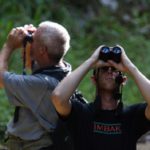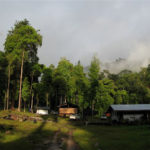Ripe Hairy Red Fruit
To get things moving I’ll publish an edited version of an email that I originally sent on 17 Oct 2004
* * * * *
I knew when I took on this job that it would involve chopping down a few rainforest trees, the justification being that you’ve got to loose a few to save a lot. This still did not prepare me for the tearing destruction of a big tree falling to the ground. The tree in question was probably over 50m tall and was undoubtedly a small ecosystem of epiphytes, lianas, frogs, insects, mosses etc all in itself. Its only crime was that it had a few large dead branches and was growing on the site that we had selected for the new Imbak Canyon Conservation Area basecamp.As if that wasn’t enough I then instructed the clearing of a large wedge of forest for the sole purpose of providing a nice view of the Imbak River from the veranda of the basecamp. In mitigation I have successfully germinated some seeds from a selection of tasty fruit that I bought in a local market. These are currently being nurtured by my ranger friends with a view to planting them in front of the veranda when the basecamp is complete.
The inspiration for this tree planting was my friend Banardus AKA Mike. 20 years ago he planted a rambutan tree at the nearby Danum Valley Field Centre and just last week I watched a young orangutan enjoying the ripe hairy red fruit of his foresight.
Back at Danum Valley I have also met a bunch of researchers from all over the world and am trying to learn from them about tropical rainforest ecology and resource management. One of their ongoing projects is the Sabah Biodiversity Experiment. This is trying to prove that if you replant logged forest with a greater diversity of indigenous tree species you get faster and more abundant re-growth.
The significance of this research is tied up in the concept of carbon trading; a development mechanism of the Kyoto Agreement. Forests sequestrate carbon dioxide and in an overheating world this is of value to us. It follows that the more carbon a forest can sequestrate the more value it has. The Kyoto carbon trading mechanism provides a means for the global community to pay for this ‘ecosystem service’.
The term ‘logged forest’ is important as there are different levels of logging, ranging from clear-cutting to reduced impact selective logging. Most of the forest that I see around the conservation areas has been selectively logged. This means that only the most valuable timber species have been taken out. The residual secondary forest has the potential to absorb additional CO2 if these large trees can be re-grown.
Obviously a virgin forest is in balance and of no value for additional carbon sequestration. Interestingly if countries have the legal right to log virgin jungle they can still claim carbon credits by opting not to log and going for conservation instead. Conservation may also bring with it many other benefits which we are only just beginning to appreciate. An example is conservation of biodiversity.
Somehow we know that biodiversity is good but it is very difficult to prove or evaluate this in absolute terms. The issues are highly emotive or speculative; such as species extinction and the possibility that we might destroy something essential before we’ve even discovered it! It is difficult to make a strong case for biodiversity conservation on these grounds alone. The Sabah Biodiversity Experiment scientists are therefore trying to prove that biodiversity has a measurable and relevant economic value in terms of carbon sequestration that can feed back into current forest regeneration and management practice.
Related Posts







I’m looking forward to see the results of the study on carbon sequestration. This will be definetely a break-thru discovery now that is known how urgent it is to fight the global warming.
Ian I didn’t know about the fruit trees you planted, I’ll love to have some rambutan next time.